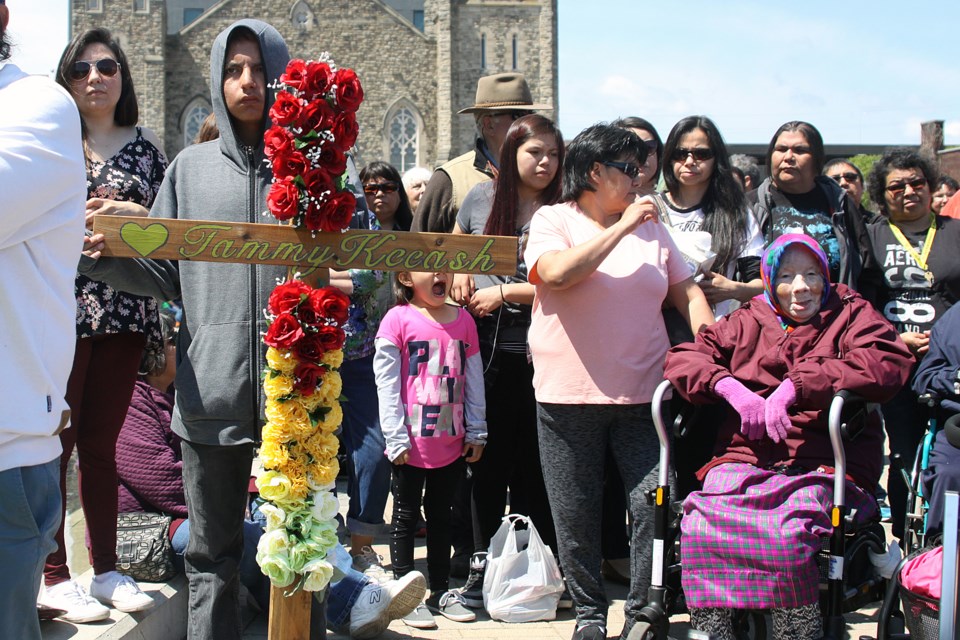THUNDER BAY – Grace Matawapit knows too well the tragic consequences that have befallen Indigenous youth in Thunder Bay.
The band councillor from North Caribou Lake First Nation, which lost 17-year-old Tammy Keeash after her body was found in the Neebing-McIntyre Floodway last month, also lost her 20-year-old grandson Daniel Levac nearly three years ago when he was the victim of a homicide in 2014.
Leaders from North Caribou Lake First Nation organized a community prayer walk Thursday afternoon to honour the memory of Keeash as well as Josiah Begg, a fellow Indigenous teen whose body was found in a Thunder Bay waterway in May. The walk began at Thunder Bay city hall and proceeded to the Thunder Bay Police Service station on Balmoral Street, with a stop at the Floodway for a brief ceremony.
Addressing the crowd of nearly 200 people – including Nishnawbe Aski Nation Grand Chief Alvin Fiddler, Thunder Bay mayor Keith Hobbs and multiple members of the beleaguered Thunder Bay Police Service – Matawapit said now is the time to come together rather than lay blame.
“We are here not to be confrontational. We are here to pray. We are here to look for healing,” she said.
“We are not here to hold up signs and protest. We’re not here to do that. We just want to heal from what we have lost. We have lost a lot of young people and we are here to heal from that. We need that and we have to believe things are going to change.”
The deaths of the two teens have sparked outrage from Indigenous leaders over the subsequent Thunder Bay police handling of the case, with Fiddler on Wednesday issuing a call for the RCMP to lead a new investigation.
Keeash was found in the Floodway on May 7, hours after she was reported missing. Police have said the coroner determined the cause of death to be consistent with drowning and there is no evidence of criminality.
Matawapit said the community has “a lot of questions” about what led to the teen’s death.
Pearl Slipperjack, the mother of Keeash, spoke briefly before the walk began.
“Thank you for supporting our family. We’re going to work together to heal together,” Slipperjack said.
The two teens were reportedly last seen the same evening, though investigators have previously said there is no evidence indicating their disappearances were connected.
Intensive search efforts to try to locate the 14-year-old from Kitchenuhmaykoosib Inninuwug First Nation were ongoing for more than a week before his body was found in the McIntyre River by a provincial police dive team on May 18.
Thunder Bay Police Service deputy chief Sylvie Hauth, who is filling in as the head of the force after police chief J.P. Levesque was placed on administrative suspension, described the walk as a “great opportunity” to come together.
“I think it’s important for them to see that we are here to work together,” Hauth said of those who have been critical of the investigations.
“We’re here to work with the city, we’re here to work with all of the organizations that are here. We’re here to work with all of the communities that are here represented and we want to be a partner at the table and work with them.”
The deaths of the two bring the number of Indigenous youth found in city waterways to seven since 2000.
Fort William First Nation Chief Peter Collins called for the memorial walk to spark a sense of unity and collaboration.
Now is not the time to be “pointing fingers and blaming each other,” Collins said, adding the focus should be on developing solutions.
“They’re part of bringing better outcomes for the visiting young people that come into our community and into Thunder Bay,” Collins said.
“One of the things I always struggle with is having them come here and there are no real opportunities for them. They get lost in the street … One of the things I think we really need to look at is creating opportunities, creating more education, creating awareness and building those things together.”
Matawapit wants to see a path forward to allow youth to come to Thunder Bay safely.
“We have a lot of young people at home that are going to be coming out for high school and we don’t want fear. We don’t want them to live in fear while they are living in the city,” she said.
“We want them to feel like other teenagers. We want them to learn and want their education.”
